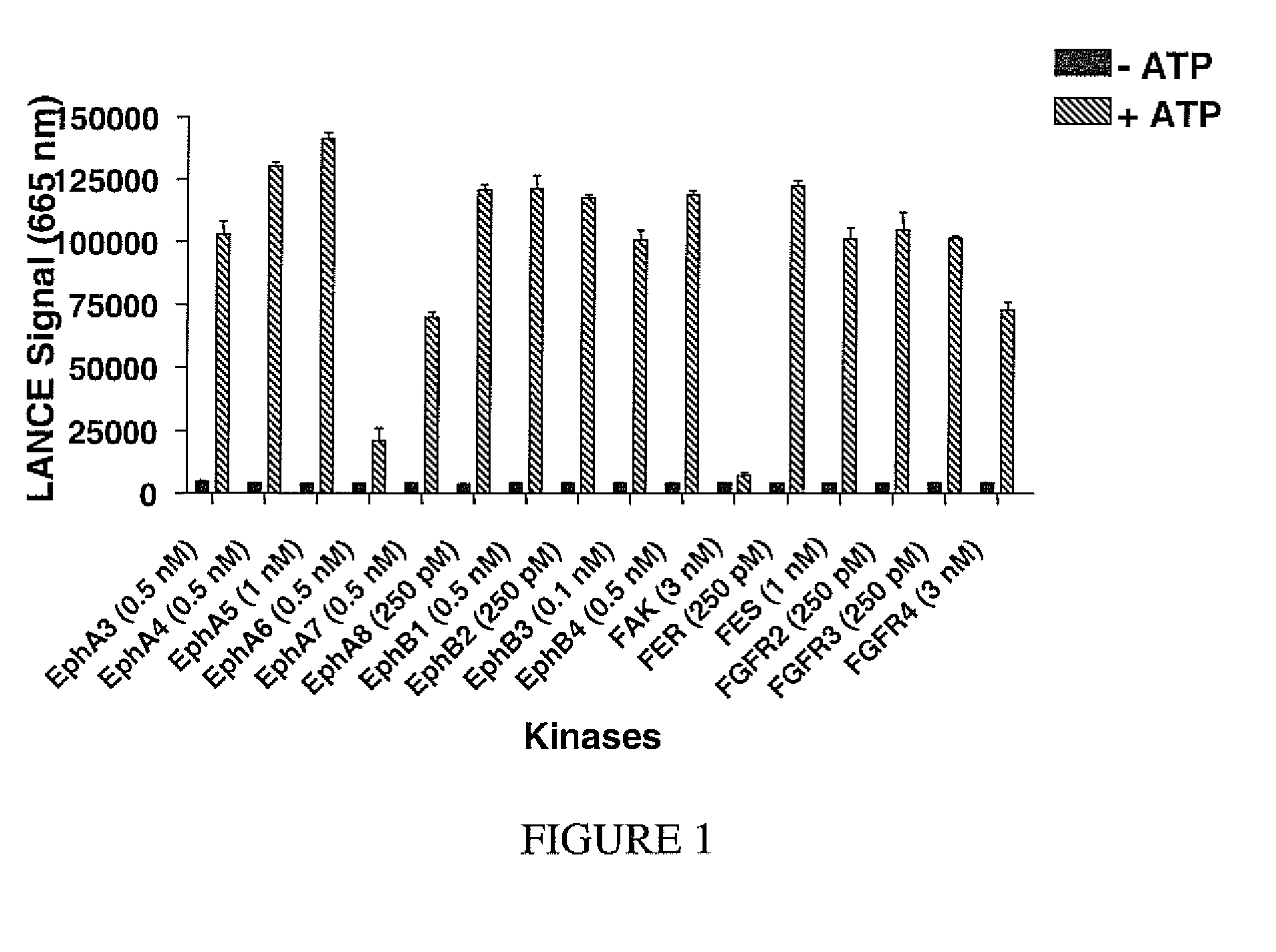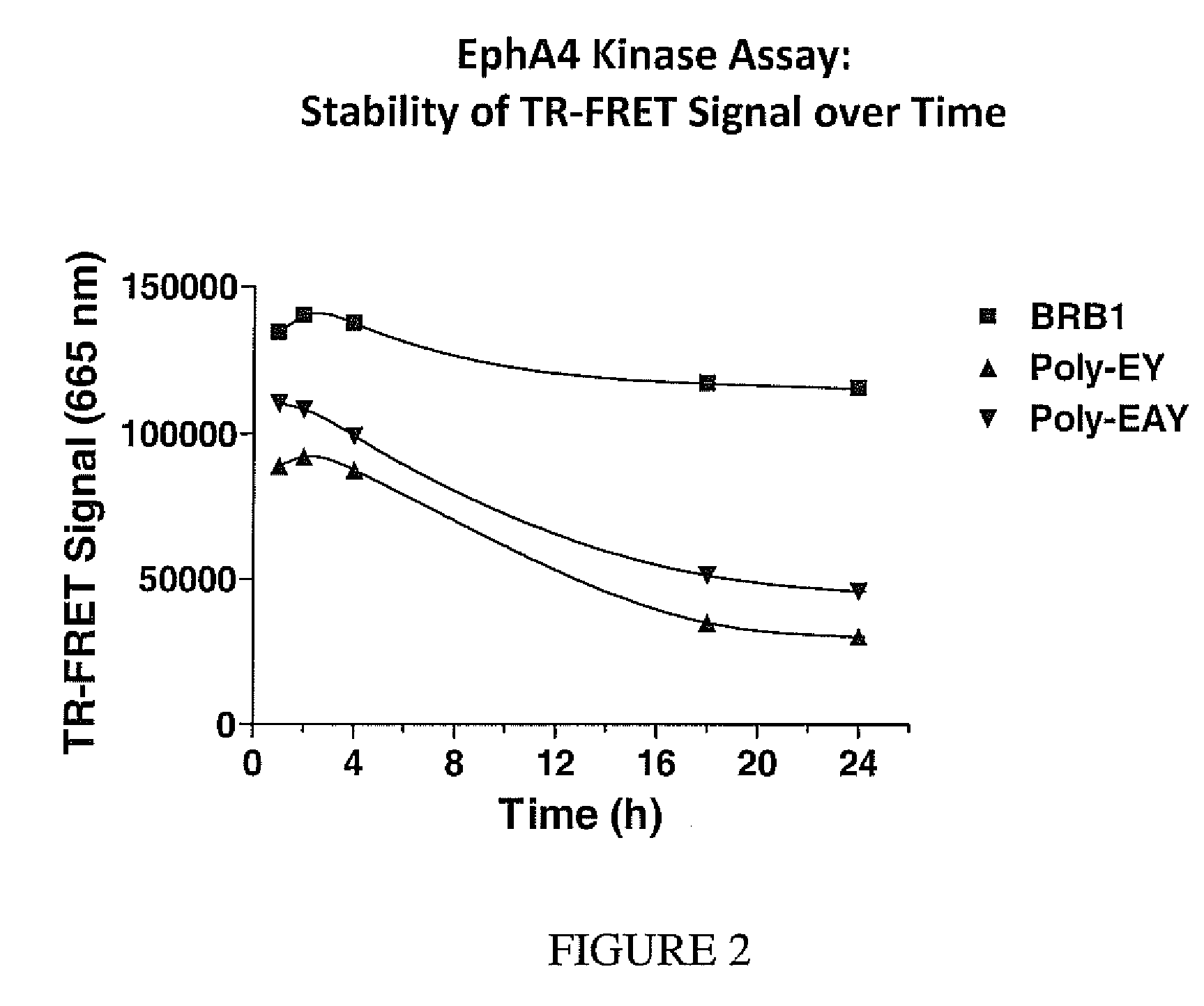Kinase substrates
a technology of kinase substrates and substrates, which is applied in the direction of transferases, peptide sources, instruments, etc., can solve the problems of variability in the labeling of dyes, fluorophores or tag groups, and/or the performance of kinase assays, and/or the heterogeneous mixture of random co-polymers
- Summary
- Abstract
- Description
- Claims
- Application Information
AI Technical Summary
Benefits of technology
Problems solved by technology
Method used
Image
Examples
example 1
[0103]The peptide of SEQ ID No. 1 is modified for labeling by addition of an N-terminal cysteine and by addition of a C-terminal basic amino acid to increase solubility at low pH. The resulting exemplary tyrosine kinase substrate peptide, termed BRB1: C AYE AYE AYE K EYA EYA EYA K AYA EYE R (SEQ ID NO:3), is generated using well-known methods of peptide chemical synthesis. The BRB1 tyrosine kinase substrate peptide contains eight tyrosines, some of which are in the same module context (AYE and EAY) while other others are in a unique module context (AYA and EYE). The BRB1 tyrosine kinase substrate peptide includes three positively charged residues which improve solubility at lower pH.
[0104]TR-FRET kinase assays are performed under standardized conditions: various individual kinases are incubated with 50 nM of kinase substrate BRB1 labeled with the TR-FRET acceptor dye ULight (PerkinElmer) and 200 micromolar ATP in 10 μL of kinase assay buffer (50 mM HEPES pH7.5, 10 mM MgCl2, 3 mM MnC...
example 2
[0106]To demonstrate further its function as a generic tyrosine kinase substrate, the dye-labeled peptide of SEQ ID No. 3 is used in 83 TR-FRET kinase assays with the europium-labeled-anti-phospho-tyrosine antibody PT66. Assay conditions are identical to those used described for FIG. 1.
[0107]Tables I and II show that 72 kinases tested out of 83 (87%) phosphorylated peptide of sequence ID No. 3, with a signal to noise ratio of >3.
TABLE ICytoplasmic Tyrosine KinasesSignal toKinaseNoise RatioKinaseConcentration (nM)with BRB1 PeptideABL0.254.1ABL [T315I] (ABL1)0.54.8ACK2017.3ARG0.510.6BLK0.531.0BMX0.57.1BRK32.4BTK0.256.8CSK2027.2CTK202.5FAK31.7FER0.2531.0FES124.9FGR0.129.3FRK0.59.7FYN0.2525.9HCK0.2529.7ITK0.58.4JAK1713.7JAK2135.5JAK30.516.1LCK0.512.3LYNa0.532.5LYNb133.1PYK20.252.9SRC0.531.7SRM0.532.5SYK0.524.6TEC0.518.6TNK116.8TXK35.9TYK247.3YES0.2528.0ZAP7047.6
TABLE IIReceptor Tyrosine KinasesSignal toKinaseNoise ratioKinaseConcentration (nM)with BRB1 PeptideALK48.8AXL41.8DDR10.51.0DDR...
example 3
[0108]In contrast to substrates of the present invention experiments showed that in TR-FRET kinase reactions containing labeled poly-EY or poly-EAY co-polymers and a europium-labeled anti-phospho tyrosine antibody for the capture of the phosphorylated polymers, specific signal at 665 nm is very unstable over time. An assay comparing the stability of the random co-polymers poly-EAY, poly-EY and peptide BRB1 (SEQ ID No.3) is performed in 384-well format. Assay conditions are similar to those used in Example 1. The Eph4A tyrosine kinase is assayed at 2 nM with 50 nM of labeled peptide of SEQ ID No. 3, 200 nM labeled poly-EY or 200 nM poly-EAY and 50 micromolar ATP in 10 μL of kinase assay buffer. The reaction mixture is incubated for one hour at room temperature. Reactions are stopped with EDTA, and anti-phospho-tyrosine antibodies (clone PT66) labeled with the TR-FRET europium chelate donor dye are added to a concentration of 2 nM in a final volume of 20 μL. The TR-FRET signal emitted...
PUM
| Property | Measurement | Unit |
|---|---|---|
| molecular weights | aaaaa | aaaaa |
| molecular weights | aaaaa | aaaaa |
| volume | aaaaa | aaaaa |
Abstract
Description
Claims
Application Information
 Login to View More
Login to View More - R&D
- Intellectual Property
- Life Sciences
- Materials
- Tech Scout
- Unparalleled Data Quality
- Higher Quality Content
- 60% Fewer Hallucinations
Browse by: Latest US Patents, China's latest patents, Technical Efficacy Thesaurus, Application Domain, Technology Topic, Popular Technical Reports.
© 2025 PatSnap. All rights reserved.Legal|Privacy policy|Modern Slavery Act Transparency Statement|Sitemap|About US| Contact US: help@patsnap.com


